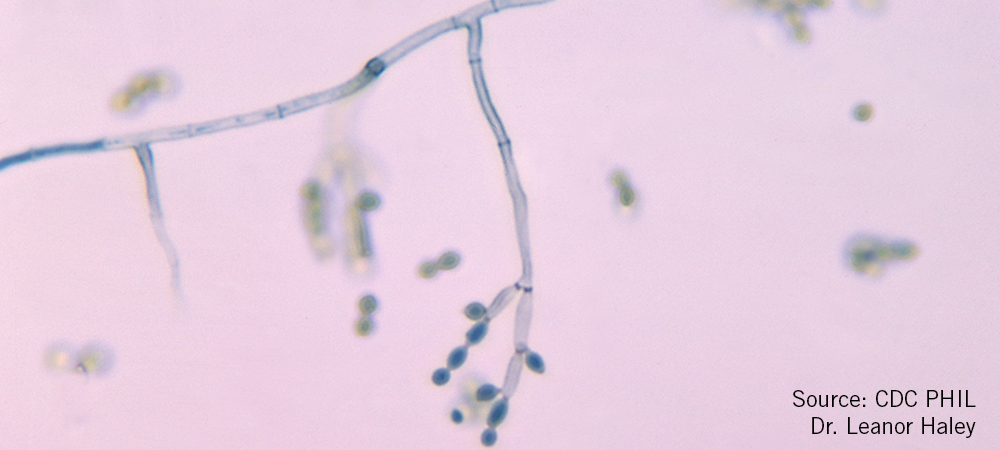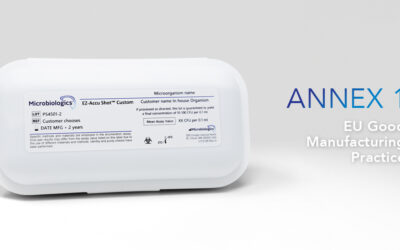Cladosporium cladosporioides, although generally nonpathogenic, can cause illness. This species, along with Exserohilum rostratum and Aspergillus fumigatus, was one of the pathogens isolated during a multistate outbreak of fungal meningitis due to contaminated sterile medication manufactured by the New England Compounding Center.2,5,9
Colony Appearance:
The colonies on malt extract agar are olivaceous-green or grayish-green. They begin as velvety but become powdery due to abundant conidia. The reverse side is greenish-black.11
Microscopic Characteristics:
Conidiophores arise from hyphae, bearing conidial chains laterally and terminally. Conidia are ellipsoidal to lemon-shaped, smooth-walled, olivaceous and easily liberated.7
Conditions for Growth:
Grows optimally within a temperature range of 18-28 °C. C. cladosporioides is considered to be xerophilic and xerotolerant, meaning it is capable of growth at or below a water activity (aw) of 0.85. It is also psychrophylic as demonstrated by its ability to grow at freezing temperatures. It can grow at a slower pace at temperatures between -10°C and -3°C on Potato Dextrose Agar and Malt Extract Agar.10

Top 3 mold species found in Miami on July 17, 2017; Source: AAAAI
Habitat:
C. cladosporioides is widely prevalent in outdoor air and on decaying organic material. These fungi are frequently found as contaminants on food.10 It can also be found on in areas where moisture is present. In field studies this genus was found within 70% of examined dwellings in the U.S.A.10
The American Academy of Allergy Asthma & Immunology (AAAAI) occasionally lists types of mold, including Cladosporimum, found in a city on a specific day. For example, the top three species of molds seen in Miami on July 17, 2017, were Cladosporimum, Smuts/Myxomycetes and Curvularia.1
Pathogenicity:
C. cladosporioides is a common air-borne saprobe that has been associated with indoor allergies.3 Cladosporium species is a rare cause of human illness, but it has been known to cause several different types of infections including skin, eye, sinus and brain infections.4 Rarely, it can cause onychomycosis (nail infection).8
Environmental Risk:
C. cladosporioides favors moist areas for growth such as:
- Buildings where the indoor humidity is higher than 50 percent
- Damp areas such as basements and carpet pads
- Buildings that have been exposed to excess moisture
- Buildings with poor ventilation3
The species thrives on cellulose based material such as wood and paper.2 Cladosporium species is more likely to be found in a support area than an aseptic processing area of a pharmaceutical facility. Over an eight year period at one sterile product manufacturing plant, 28% of the fungal species isolated in the class D area were Cladosporium spp.6
Taxonomy10
| Kingdom: | Fungi | Order: | Capnodiales |
| Phylum: | Ascomycota | Family: | Davidiellaceae |
| Class: | Dothideomycetes | Genus: | Cladosporium |
References:
1 AAAAI. NAB Station: Florida Center For Allergy & Asthma Care. 7/17/2017 http://pollen.aaaai.org/nab/index.cfm?p=allergenreport&stationid=222&datecount=07%2F17%2F2017
2 Abraham, Z. (2013) Understanding, Preventing, and Remediating Mold in Cleanrooms IVT Network. http://www.ivtnetwork.com/article/understanding-preventing-and-remediating-mold-cleanrooms
3 CDC. (2017) Mold Allergy. http://www.mayoclinic.org/diseases-conditions/mold-allergy/symptoms-causes/dxc-20200846
4 CDC. (2017) Cladosporium https://www.cdc.gov/fungal/diseases/other/cladosporium.html
5 CDC. (2017) Multistate Outbreak of Fungal Meningitis and Other Infections. https://www.cdc.gov/hai/outbreaks/meningitis.html
6 Cundell, Tony. (July 30, 2016) Mold Monitoring and Control in Pharmaceutical Manufacturing Areas. American Pharmaceutical Review. http://www.americanpharmaceuticalreview.com/Featured-Articles/190686-Mold-Monitoring-and-Control-in-Pharmaceutical-Manufacturing-Areas/
7 de Hoog, G.S., Guarro, J., Gené, J., Figueras, M.J. (2000) Atlas of Clinical Fungi 2nd Edition.
8 Dongmei Shi et al. Open Journal of Clinical and Medical Case Reports. (2016) Volume 2. Issue 2. ISSN 2379-1039. http://jclinmedcasereports.com/articles/OJCMCR-1072
9 FDA. U.S. Food and Drug Administration 2012) Multistate state outbreak of fungal meningitis and other infections
10 INSPQ. Centre d’expertise et de référence en santé publique. Institut national de santé publique Quebéc. https://www.inspq.qc.ca/node/488
11 Samson, R., Hoekstra, E., Frisvad, J., Filtenborg, O. (2002) Introduction to Food and Airborne Fungi, 6th Edition.






0 Comments